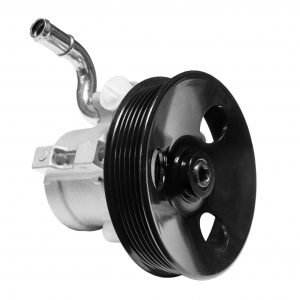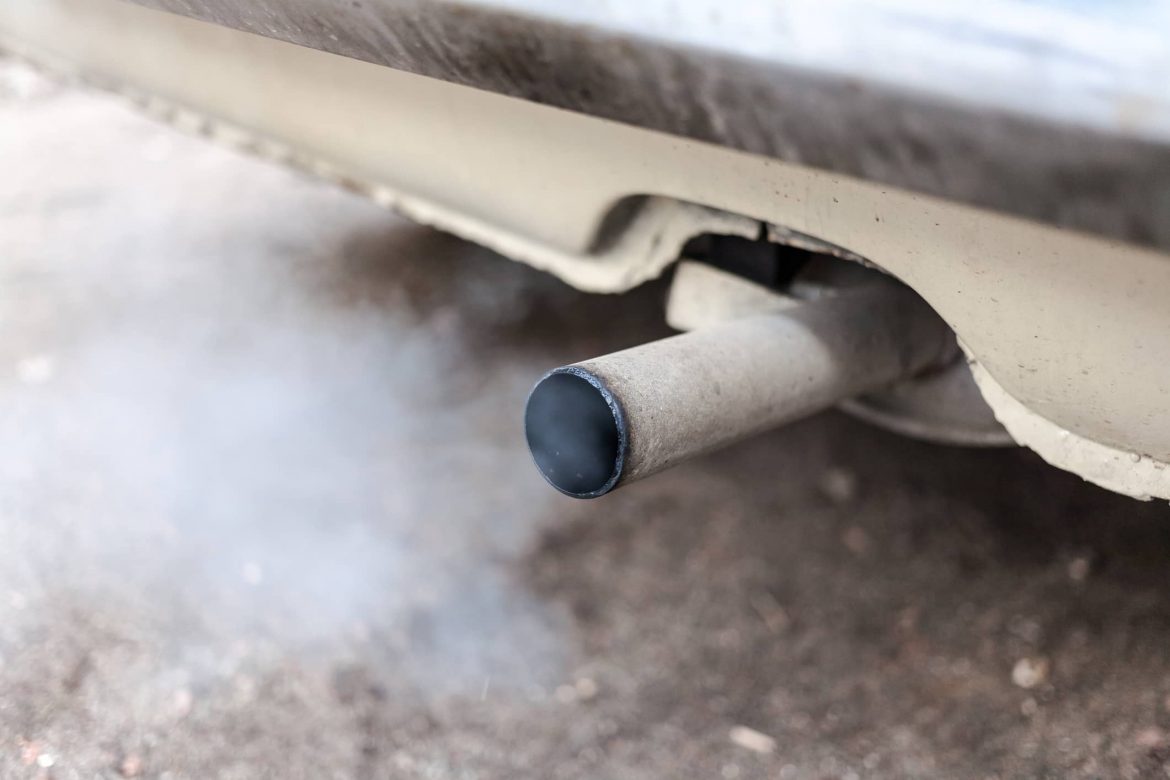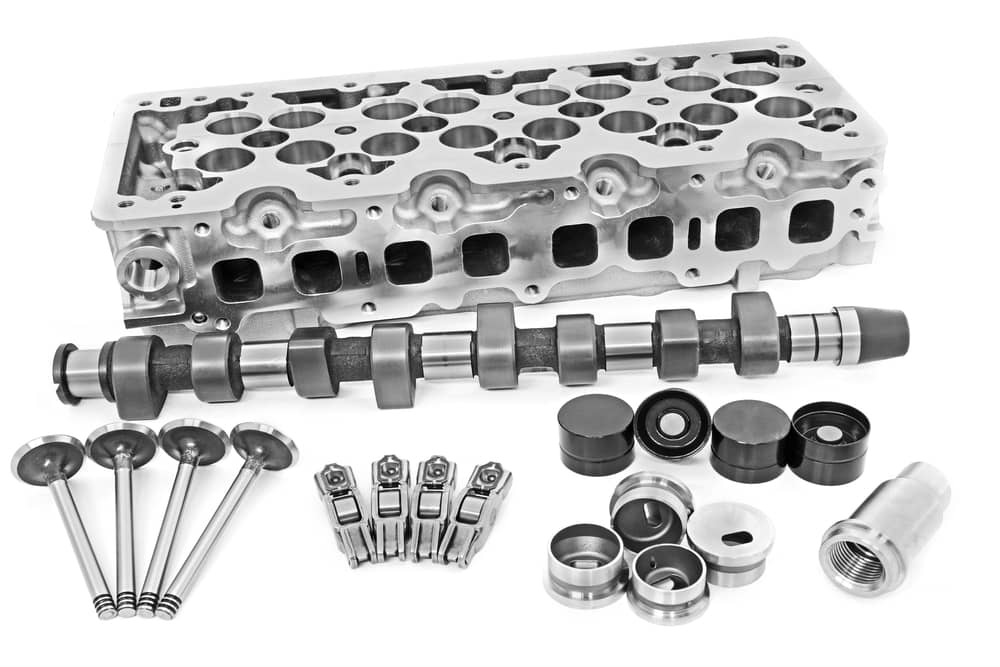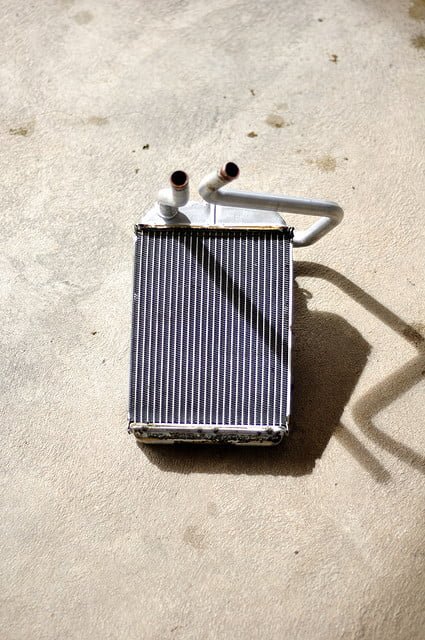 Power Steering was one of the first luxury items available on modern day automobiles. Early automobiles had wheels that resembled wagon wheels or bicycle wheels so they were fairly easy to turn using just a steering wheel. A large diameter steering wheel combined with the right mechanical linkage was a very effective method of turning the front tires of your vehicle. As vehicles got heavier and were able to drive faster, wider and wider tires were required to maintain traction and carry the weight of advancing automobiles. Wider tires in turn were much harder to turn than the old skinny tires on early cars and as tires grew they eventually necessitated a system that could assist the driver in turning them at lower speeds or at a stop.
Power Steering was one of the first luxury items available on modern day automobiles. Early automobiles had wheels that resembled wagon wheels or bicycle wheels so they were fairly easy to turn using just a steering wheel. A large diameter steering wheel combined with the right mechanical linkage was a very effective method of turning the front tires of your vehicle. As vehicles got heavier and were able to drive faster, wider and wider tires were required to maintain traction and carry the weight of advancing automobiles. Wider tires in turn were much harder to turn than the old skinny tires on early cars and as tires grew they eventually necessitated a system that could assist the driver in turning them at lower speeds or at a stop.
Many car companies allowed drivers to muscle through steering these larger wheeled cars through the 60s and 70s. By the 1980’s powers steering was an option that just about every new car had. Since the early 90s, it has been almost impossible to purchase a car without power steering.
Since its invention, power steering systems have been almost exclusively hydraulic. In these systems, a hydraulic pump pressurizes a hydraulic working fluid which is used to power a steering gear or rack and pinion. The steering rack or gear uses the hydraulic fluid pressure to move the tie rods and turn your front wheels.
In the early 2000’s, some car manufacturers started experimenting with using high torque electric motors coupled to variable gearboxes to assist the driver in turning the wheels of their car. These systems are simple and very efficient and a great next step in power steering in today’s vehicles.
If you’re like most drivers, you have a hydraulic power steering system in your car and if you’re reading this article then it is probably giving you some trouble. Power steering systems can alert you to a problem in two different ways. First, you may experience difficulty turning your steering wheel or experience dead spots or rough patches throughout your steering wheel’s circle. The other way your power steering system will let you know something wrong is through whining in the pump.
If you’re experiencing dead or rough spots in your steering, your problem is either in the linkage of your steering column or in your steering rack or gear. Your steering wheel is connected to the hydraulic portion of your system using a series of shafts and universal joints. It is possible that your steering shaft is binding on something, or has become tangled in wiring. It is also possible that the joints in your steering column have come loose or require lubrication. You can usually check for this by locating your steering shaft in your engine bay and visually inspecting the shaft and joints. It will start at the firewall behind your steering wheel and travel down to the steering rack or gear at the bottom of your engine bay. These rough spots could also be caused by a clog or blockage in your steering gear. Unfortunately, it is almost impossible to inspect for this problem so the best course of action is to get a power steering system flush and see if the situation improves.
Most often power steering system problems are evident in a power steering pump whine. Once you’ve heard a power steering noise, they can be easy to pinpoint in the future. Try doing a quick internet search for “power steering pump whine” followed by your car make and model to see if you can find an example of the sound.
Power steering pumps make this signature whine due to the rotary vane style of the pump. A power steering pump may whine for 3 different reasons:
- Pump Failure
- System Clog
- Low Fluid Level
 If your power steering pump is wearing out, the bad bearings will allow enough shaft movement to cause your pump to whine. If this is the case you can often feel it by spinning the power steering pump pulley by hand. It will either wobble or be surprisingly difficult to turn. A system clog also causes your power steering pump to whine as it raises the pressure in the system so high the pump will get noisy. As stated before, the only thing to do here is try flushing your system to see if it quiets things down. Lastly, a low fluid level will cause your power steering pump to whine as it fights for fluid and as air becomes entrapped in the fluid.
If your power steering pump is wearing out, the bad bearings will allow enough shaft movement to cause your pump to whine. If this is the case you can often feel it by spinning the power steering pump pulley by hand. It will either wobble or be surprisingly difficult to turn. A system clog also causes your power steering pump to whine as it raises the pressure in the system so high the pump will get noisy. As stated before, the only thing to do here is try flushing your system to see if it quiets things down. Lastly, a low fluid level will cause your power steering pump to whine as it fights for fluid and as air becomes entrapped in the fluid.
A low power steering fluid level is easy to spot by checking the fluid level in your reservoir. If you discover a low power steering fluid level it is an indication that you’ve got a leak somewhere in your system. Rather than spending time and energy searching for a leak, simply add BlueDevil Power Steering Stop Leak to your reservoir with your top-off fluid and continue to drive! BlueDevil Power Steering Stop Leak will seal the leak in your system by reconditioning the seals stopping the leak.
For more information about BlueDevil Power Steering Stop leak, check out our product information page here: Power Steering Stop Leak
You can purchase BlueDevil Power Steering Stop Leak at the link above, or at any of our partnering local auto parts stores like:
- AutoZone
- Advance Auto Parts
- Bennett Auto Supply
- CarQuest Auto parts
- NAPA Auto Parts
- O’Reilly Auto Parts
- Pep Boys
- Fast Track
- Bumper to Bumper Auto Parts Specialists
- S&E Quick Lube Distributer
- DYK Automotive
Pictures Provided By:
power_steering.jpg – By Fuse – Licensed by Thinkstock Photos – Original Link
power_steering_pump.jpg – By Phantom1311 – Licensed by Thinkstock Photos – Original Link
BlueDevil Products can be found on Amazon.com or at AutoZone, Advance Auto Parts, O’Reilly Auto Parts, NAPA, and other major auto parts retailers.
30 responses to "Fix Your Power Steering Problems!"
30 Comments
Leave a Reply
Related Articles





i have a 2005 acura tsx 2.4,replaced power strg pump,still no power strg please help,fyi was leaking now not leaking what did i do wrong/////////
Patrick,
Thanks for your question about your Acura TSX. It is possible that your power steering system still has so many air bubbles in it that it isn’t creating the proper pressure in your system to give you power assist. Try raising your front tires off the ground and turning the wheel from lock to lock a few times and checking to see if the level in your power steering fluid reservoir goes down. Once the level stops going down with the car off, try starting your engine and trying the same procedure.
If you’re sure your power steering system is full of fluid and properly bled, you may have a clog somewhere in your system preventing fluid flow, possibly in your steering rack or the return line.
Thanks again for your question!
-BD Auto Pro
I have a 2008 Uplander. I have replaced the power steering pump 3 times now (March 2015, Oct 2015 and the most recent time Fri Feb 12th ) and the rack once (Nov 2015) and the tension-er belts( Jan 2016.) . I am so frustrated with all the money I have spent on this, I still have the power steering whine. In fact it’s even worse with the last fix. I have had the transmission checked twice and both times it was confirmed without a doubt it was the power steering pump. WHAT could be the cause of the constant whine.??? any advise would be helpful. Please.
Sharon,
You’ve certainly replaced just about ever part of your power steering system. The only thing left original sounds like the hoses and lines. It is possible that one of your high pressure lines has a clog in it which would cause your pump to whine. You may consider replacing that high pressure line to see if that helps at all. Also, if the power steering pumps you’ve used are remanufactured or replacement pumps rather than original equipment supplied by Chevrolet you may consider having a OEM Chevy power steering pump installed to see if that helps at all.
Thanks again for your question!
-BD Auto Pro
Please let me know, what causes my hydraulic power steering rack system when you turn one side the hydraulic spread out and other side not?
Makori,
Thanks for your question about your power steering. It sounds like you’ve got one side extending when you turn and the other side now. If one side works and the other doesn’t then you’ve got an internal failure in your power steering rack and will need to replace it. Unfortunately, you probably won’t be able to rebuild the steering rack but will simply have to replace the whole unit.
Thanks again for your question!
-BD Auto Pro
05 Kia Amanti, New power steering seems to perform fine under 2000 rpm. System has been bled. When I take rpm up to around 3000 fluid fly out around the pump pulley (seal failure) however;back at idle it seems ok – no apparent leak. I have replace the pump 3 times. first replacement I assumed reman pump had a shaft seal failure.
This vehicle had a pump replacement around 30,000 miles, when we bought it. That pump failed around 150,000. 2nd replacement had “front seal failure” out of the box. the next replacement pump lasted to about 230,000. I am now on my second replacement pump. Both pumps were bled down (no whine at idle, except at hard stop, either right or left). At 3000 rpm what appears to be a front seal failure occurs. System has been bled empty twice via vacuum on the return hose. Where do I go next?/
Jerry,
Thanks for your question about your Kia Amanti. It sounds like you’re in for another power steering pump replacement. This time you find try to find a genuine OEM pump to make sure you’re getting the best quality. The other thing to check is to make sure you’re using the correct power steering fluid as the wrong fluid could be causing premature failure of the pump shaft seal. Lastly, we would recommend flushing the whole system after you install the new pump to make sure any debris that could cause wear have been flushed out and new clean fluid is added to maker sure you don’t get excessive wear again.
Thanks again for your question!
-BD Auto Pro
Hi I hope u can help, we have a 2003 mini one, we have replaced with both new power steering pump & a new power steering rack, we still don’t have power steering, we have had the car front off the ground & turned the wheels to remove the air in the system and still no power steering, please can you help us, thanks
Freda-
Thank you for asking about your Mini Cooper. Are you noticing a loss of power steering fluid? If so, we recommend using the BlueDevil Power Steering Stop Leak (http://store.gobdp.com/power-steering-stop-leak-00232/). You will be adding 1/3 of the bottle into your power steering reservoir and should expect to see results after about 100-200 miles of driving.
Thank you!
-BDP
I have a 2002 kia Sedona the van is making a kid growling noise and now the power steering is out are these related and also what could be the power steering problem
James-
Thank you for asking about your Kia Sedona. Have you noticed a loss of power steering fluid? If so, we recommend using the BlueDevil Power Steering Stop Leak (http://store.gobdp.com/power-steering-stop-leak-00232/). You should expect to see results after about 100-200 miles of driving.
Thank you!
-BDP
Have a 2001 dakota. I changed the b rack and ranngreat for a day. Now it is hard to turn. No leaks and fluid is good. No noise either. HELP
John-
Thank you for asking about your Dodge Dakota. Based on your description, it’s possible a faulty power steering pump is the culprit for your power steering problems. Unfortunately, a hard part repair would be your best option for this type of issue.
Hope this helps!
-BDP
I have a 2016 chevy Cruze LT 1.4L.
The car has a mechanical assistant power steering. The issue I have is on the Dic says serivice power steering but the power steering check engine light doesn’t come on and chevy said they never heard of this issue before. I had the body control module and pcu reset and the dic still says service power steering, the car also has 38k miles. Hope u might have any pointers.
David-
Thank you for asking about your Chevy Cruze. 38k miles is awfully low to be having any type of power steering service, let alone a maintenance service. The problem does sound electrical, however, it could be something as simple as one of the fuses have blown or one of the relays is not connected properly. If that is not the case, we recommend bringing the vehicle to Chevrolet for a proper diagnosis.
Thank you!
-BDP
2006 chevy trail blazer that I just had a bearing replaced on. Now when I turn right it is very hard. Turning left is fine
Heidi,
Thanks for your question about your 2006 Chevy Trail Blazer. The wheel bearing on your truck should be a unit bearing meaning it bolts to the knuckle and very little should be disturbed during the installation. You might have the shop that did the work check the torque on the axle nut bearing to make sure it was set correctly, but besides that our guess is that the hard turning is a coincidence with the wheel bearing replacement. That hard turning could be due to a tie rod end going bad, a clog in your steering rack or even an internal failure in your steering rack.
Thanks again for your question!
-BD Auto Pro
Got a kia spectra 4 cyl keeps squellin when I turn start it . When it’s parked and I start it and turn get dead spot like it’s full lock to one side then goes away and can turn more when I force it to go . Car has new belt . Power steering has its own belt .
Ms,
Thanks for your question about your Kia Spectra. For the belt squealing, try reading our article about that here: https://gobdp.com/blog/engine-belts-squeal/. You may simply have to increase the tension on your power steering belt. You might also try checking the power steering fluid as a low fluid level could cause the squealing and the dead spots while you’re turning your wheel. If you find a low fluid level, add BlueDevil Power Steering Stop Leak (available here: http://store.gobdp.com/power-steering-stop-leak-00232/) and top off your power steering fluid. If you don’t find a low fluid level, you may need to replace your power steering pump.
Thanks again for your question!
-BD Auto Pro
I have a 2007 F150, my power steering seems to bind as turning, then feels really free and binds again like I have no power steering. The truck has relatively low miles on it for its age and was wondering if perhaps the seals dried up somehow? What causes the steering to feel “binded” up
James-
Thank you for asking about your Ford F-150. When you say “binded up,” are you referring to the vehicle becoming difficult to turn? If so, that could be due to a lack of power steering fluid. We recommend checking the system to see if the fluid is topped of to the proper level. If not, top the power steering fluid off and add the BlueDevil Power Steering Stop Leak. The product will stop the loss of fluid and return your power steering back to normal functionality.
Thank you!
-BDP
got and 2003 suzuki xl-7 replaced the fluid two time just had a cv axle replaced on driver side and now when i drive and turn either left or right i have a hard spot in a couple of spot in turning either way what culd be the problem and a quick fix just going to be running the suv for a few more months and done want to wreck between now and then please help
Dustin-
Thank you for asking about your Suzuki xl-7. Are you noticing a loss of power steering fluid? If so, we recommend using the BlueDevil Power Steering Stop Leak (https://store.gobdp.com/power-steering-stop-leak-00232/). You will begin by adding 1/3 of the bottle into your power steering reservoir, and should expect to start seeing results after approximately 100-200 miles of driving. Top the system off with power steering fluid as needed to ensure it is at the proper level.
Thank you!
-BDP
09 ford escape 3.0 when Turing the steering wheel tightens up? Why
Stacy-
Thank you for asking about your Ford Escape. Have you noticed whether the power steering fluid appears low? If so, we recommend using the BlueDevil Power Steering Stop Leak to help stop the loss of fluid and return the system to normal functionality. You will begin by adding 1/3 of the bottle into your power steering reservoir, and should expect to start seeing results after approximately 100-200 miles of driving.
Thank you!
-BDP
2001 Dodge Dakota, Recently had the power steering pump replaced. Now the power steering will quit and then come back and then quit again? any ideas on what is going on.
Thanks in advance
Lynnzie-
Thank you for asking about your Dodge Dakota. Based on your description, there may be an issue with the power steering pump that was just replaced not circulating the fluid correctly. Being that it sounds like this work was just performed, we recommend going back to the shop that did the work to take a look at the power steering pump.
Thank you!
-BDP
I have a ’09 MB ML350 4Matic with 123,301 miles on it at the present time. Last year, noticed a severe whining sound that’s really annoying so I had the same checked and diagnosed by my Mechanic. Based on his expert findings and prognosis, recommended to change the faulty P/Steering Pump, which he avers to be the culprit why it’s emitting that awful sound. He also suggested to have the P/S Reservoir Tank replaced, of which he discovered a small cracked, which according to his expert opinion is also a factor in the same whining sound issue. And while he’s at it, ended up changing the Serpentine Belt, Pulley, Tensioner and Idler as well, which really cost me an arm and a leg. Honestly and believe it not, have no issue with the funds involved as long as the problems at hand were addressed. All these works were done on December last year, 8 months past.
Here’s the kicker, couple of months later on after the above mentioned repair works, still hearing the same sound before the job was done. Went back to him for consultation on the same issue as before. This time he attributes it to a Rack and Pinion leak that he found after he checked. I was hoping that your expert outfit would be able to shed light on the matter, before my warranties run out. Crying for help.
TDLR-
Thank you for asking about your Mercedes Benz ML350. A whining noise coming from the power steering system would typically indicate air being trapped in the system, via a leak. The rack and pinion seal would be the most common leak point. It’s possible that if the leak was so small and undetectable, that is was the culprit for the whining sound the whole time. If the vehicle is still under warranty, we recommend bringing it back to the shop for repair.
Thank you!
-BDP